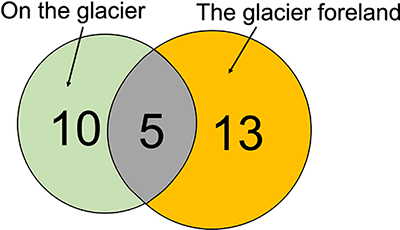National Institute of Polar Research
Melting Arctic glaciers see drop in fungi biodiversity
March 31 2022
Scientists investigating fungal biodiversity on glaciers undergoing rapid ice loss in the Canadian High Arctic have found that such glacier retreat is causing loss of habitat for fungi on glaciers.
A paper describing the researchers’ findings appeared in the journal Sustainability on Jan. 29.

(From left) Location map of Ellesmere Island and Walker Glacier in the Canadian High Arctic and Walker Glacier retreat area. © Yukiko Tanabe(NIPR)
From the plight of polar bears to unprecedented wildfires in the Arctic, the public is increasingly familiar with biodiversity and habitat loss amongst animals and plants in far northern latitudes. Similar threats to fungal biodiversity however receive little attention. Fungi play crucial roles in the nutrient cycle of High Arctic ecosystems as decomposers, however, just as they do in all ecosystems. In particular, Arctic glaciers provide unique habitats for microbial communities. Yet little is known in particular about the fungi that live on glaciers in these regions.
So the researchers visited Walker Glacier on the far northern coast of Ellesmere Island in the territory of Nunavut in the Canadian High Arctic, where over the past two decades, global warming has profoundly affected the local cryosphere. This coastal zone is also the terrestrial margin of the ‘Last Ice Area’ (LIA), which contains the thickest ice in the Arctic Ocean and is viewed as the last refuge for many polar species as the world heats up. But even here, rapid warming and ice attrition has been observed in the LIA, with associated loss of ice-dependent habitats at its coastal margin. The Walker Glacier here has retreated over 80 meters over the past seven decades, and in recent years, the rate of retreat has accelerated sharply, losing 3.3 meters per year.
Initial research by the team had discovered four new basidiomycete yeasts in the LIA coastal region, and another two at the Walker Glacier. These early findings inspired the group to consider how the rapidly changing temperature and ecosystem conditions were affecting fungal diversity by extending their investigation to cover the full range of fungal communities.
Nine sediment samples were aseptically scraped from the surface of the melting ice face and terminal deposits of Walker Glacier. The researchers then tested these samples on a variety of different culture media (different ‘recipes’ of nutrients in Petri dishes) to find which produced the best growth for the largest number of types of fungi. Different strains were then separated out (isolated) from the mixed population of microbial organisms in the samples.
There were between 23 and 37 fungal strains that were obtained from each sampling site for a total of 325 fungal strains able to be isolated. Of these, 273 were successfully extracted and analysed by DNA sequencing. The researchers were then able to classify the strains into 10 species of ascomycetes (one of the seven phyla—the taxonomic rank below kingdom—of fungi), 12 species of basidiomycetes, and 6 species of zygomycetes, as well as a five previously unclassified species.

Venn diagram showing overlapping and non-overlapping fungal species isolated from Walker Glacier and its foreland. This figure shows the formation of a unique fungal community on a glacier.
© Masaharu Tsuji (KOSEN, Asahikawa college)
Only five of the 15 fungal species isolated from the samples taken atop the glacier ice were also isolated from the glacier foreland sediment samples.
“This suggests that there is a unique set of ice-dependent fungi on Walker Glacier, with strains that were not able to compete or survive in the glacier foreland environment,” said Masaharu Tsuji of the National Institute of Technology at Asahikawa College and lead author of the study.
Fungi inhabiting the High Arctic are able to survive the extreme polar conditions of persistent cold temperatures, continuous bright light exposure, and a deep freeze during winter.
All these extreme conditions mean that they are likely to have many unusual biochemical properties. Studies of cryosphere ecosystems elsewhere have found low-temperature fungi that may have cold-active enzymes useful in industrial production, as well as other attributes potentially applicable as new drugs, bio-surfactants or other biotechnological sectors.
“A loss of such fungi before they are even discovered would be a great loss to society,” added associate professor Tsuji.
Having performed an initial investigation establishing decline in fungal biodiversity on the Walker Glacier, the researchers now want to extend their survey to other microbial species beyond fungi such as bacteria and algae at the same location to explore how they are affected by global warming.
The paper was co-authored by Dr. Warwick F. Vincent (Université Laval), Yukiko Tanabe and Masaki Uchida (National Institute of Polar Research (NIPR)).
The study was supported by NIPR through General Collaboration Project.
Original article:
Journal: Sustainability
Title: Glacier Retreat Results in Loss of Fungal Diversity
Authors:
Masaharu Tsuji (National Institute of Technology, Asahikawa College, Japan)
Warwick Vincent (Université Laval, Canada)
Yukiko Tanabe (National Institute of Polar Research (NIPR), Japan)
Masaki Uchida (National Institute of Polar Research (NIPR), Japan)
DOI: 10.3390/su14031617
URL: https://doi.org/10.3390/su14031617
Available Online: March 22, 2022
Funder:
Institute for Fermentation, Osaka, Arctic Challenge for Sustainability II (ArCS II), the Ministry of Education, Culture, Sports, Science and Technology








